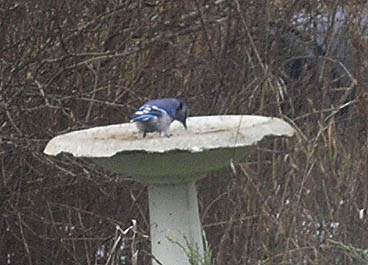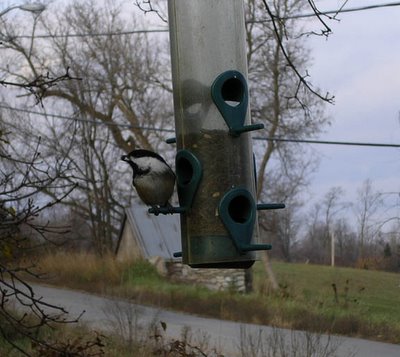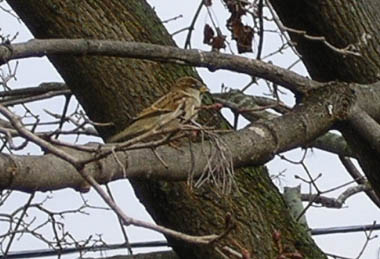This past weekend was our first two-day count period for
FeederWatch-and what a count it was! In fact, we had the highest number of species we've ever had on a first period count, and unless you exclude the Guinea fowl, the number of species, 17, is matched only by a last count period in early April a few years ago, when the list of species included a number of returning migrants. Excluding the Guinea fowl, as we must, actually, the count is our second highest on record.
 I don't know what they'll think of our inclusion of these two in the count.
I don't know what they'll think of our inclusion of these two in the count.I was particularly pleased to see the pine siskins.
 Pine siskins!
Pine siskins!But it was also a treat to finally see the flock of evening grosbeaks on the ground, 9 in total.
 Today was the first day the evening grosbeak flock landed to feed.
Today was the first day the evening grosbeak flock landed to feed.
And they did it on a count day!And the dark-eyed juncos are still here! We don't usually see them around for long in the numbers we've had over the last few weeks. And didn't one of the resident cardinals make a rare early appearance.
Here, a table of first count results going back to 1999.

The way the count works is that over two days every two weeks counters monitor the feeders and record the highest number of each species seen at one time over the period.
 The bluejays concentrate on loading up on food to store.
The bluejays concentrate on loading up on food to store. Chickadees take more away than they eat too.
Chickadees take more away than they eat too.
But at least they just take one seed at a time. This house sparrow has been hanging around all by himself.
This house sparrow has been hanging around all by himself.
Unusual for this species.
 This tree sparrow was also the only one of his kind to come to the feeders this weekend. I saw a flock of 15 or 20 in the far field Sunday morning. Maybe when there's a real snow cover they'll turn up in the yard.
This tree sparrow was also the only one of his kind to come to the feeders this weekend. I saw a flock of 15 or 20 in the far field Sunday morning. Maybe when there's a real snow cover they'll turn up in the yard.All in all, an auspicious weekend. Sure, evening grosbeaks and pine siskins have dropped by, only to leave again, before. But I'm thinking that this is going to be one excellent year.
 Here's another guest who's using the feeder to stock up for the winter.
Here's another guest who's using the feeder to stock up for the winter.















1 comment:
That's quite a nice number of birds. I have never participated in a feeder count, but I may try next year. It looks very worthwhile for contributing to the overall assessment of bird health.
Post a Comment